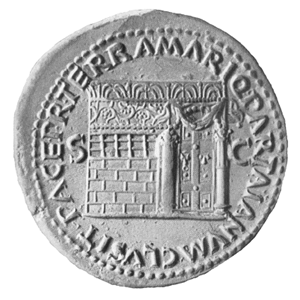

Though iani, archways, abound, why is your cult based in the one where your shrine joins two forums?"
Ovid, Fasti (I.257-258)
The Janus Geminus (to reflect his twin faces) was a small shrine that held an archaic bronze statue of the god, said to have been dedicated by Numa, Rome's second king (Plutarch, Life of Numa, XX.1-2). Pliny relates that its fingers were arranged to indicate the 355 days of the year (Natural History, XXIV.33) and Ovid, that one hand held a key (as the god of entrances), the other, a staff (to signify his authority and as a guide) (Fasti, I.99).
The doors of the Janus Geminus were opened to indicate that Rome was at war and closed during times of peace. Since the time of Numa, the doors were said to have been closed only in 235 BC, after the first Punic war; in 30 BC, after the battle of Actium; and several times during the reign of Augustus (for examples, when the Cantabrians were defeated in 25 BC, supposedly ending the Spanish wars; Livy, History of Rome, I.19; Suetonius, Life of Augustus, XXII; Plutarch, XX). Even in antiquity, the significance of the doors varied: whether peace was shut inside when the doors were closed or whether war was contained. In the Fasti, Ovid has peace released and war held captive behind barred doors (I.121-124) but then he locks peace inside (I.277-281). Or it may be that the god was thought to have gone out to assist Rome in her wars and stayed within the shrine to safeguard the city. Statius, too, has Janus withdraw behind his closed portal and then speaks of peace being put back there (Silvae, IV.1, 3). Dio recounts that, of all the honors extended to Octavian after the defeat of Antony and Cleopatra, "the action which pleased him more than all the decrees was the closing by the senate of the gates of Janus, implying that all their wars had entirely ceased" (Roman History, LI.20.4).
No archaeological remains for the location of Janus Geminus have been found, but numismatic evidence depicts a rectangular building with two arched doors opposite one another, flanked by two columns. The long sides are courses of ashlar blocks with a grating above, surmounted by a decorated frieze of serpentine vines and another with palmettes. The temple is said to have been situated between the Forum Julium and the Forum Romanum, close to where the Argiletum entered the forum. There is no literary evidence that the shrine ever was rebuilt, but it must have been moved to make way for the construction of the Basilica Aemilia in 179 BC and again by Domitian to the Forum Transitorium when he rebuilt the Curia Julia in AD 94. There, possibly remodeled as a quadrifrontal arch, a four-faced statue of Janus replaced the original bifrontal one.
Sometime before the assassination of Pertinax in AD 193 (Dio, LXXIV.13.3), a new shrine to Janus was constructed in front of the Curia, built of bronze (or perhaps only the interior was sheathed in bronze) and just big enough to house a large statue of the god (Procopius, Gothic Wars, V.25.18ff.). By then, relates Procopius, the custom of opening the doors when at war was abandoned, in deference to Christian teaching.
Janus was the Roman god of passages, both topographical and temporal. The word, itself, is linked with janus "archway" and janua "passage, gate" and can refer to the god and to the passageways connected with him. He also was the doorkeeper (janitor), a god of openings and beginnings (for example, Januarius). Macrobius elaborates on the role in the Saturalia (I.9). That Janus is the first name called upon when the gods are worshiped is because the prayers of supplicants are conveyed through his doors. For this reason, he also was considered the doorkeeper of heaven and hell. His four faces look toward the four corners of the world, as though his greatness embraces all regions. After the Julian reform of the calendar, the fingers of Janus were said to represent 365 days.
The sestertius above was issued by Nero to commemorate the end of an inconclusive Parthian campaign. This Neronian Janus has walls of ashlar masonry under a grated window set beneath a decorated attic. Double doors are shown framed by columns, with a wreath hanging overhead. Presumably, there were similar doors at the other end, the geminae belli portae through which, as Virgil relates, the procession passed (Aeneid, VII.607ff). No roof is indicated and there may not have been one. The large grated windows suggest, however, a flat roof.
The obverse reads PACE P R TERRA MARIQ PARTA IANVM CLVSIT, "The Peace of the Roman People having been established on Land and Sea, he closed Janus." Several years later, the doors would be opened again when the Jewish war began in AD 66.
References: Ovid: Fasti (2000) translated by A. J. Boyle and R. D. Woodard (Penguin Classics); "The Curia Julia and the Janus Geminus" (1978) by Lawrence Richardson, Jr., Des Deutschen Archaeologischen Instituts Römische Abteilung, 85, 359-369; The Historical Topography of the Imperial Fora (1984) by James C. Anderson; Brill's New Pauly: Encyclopaedia of the Ancient World (2002-) edited by Hubert Cancik and Helmuth Schneider (a translation of Der Neue Pauly: Enzyklopadie der Antike); Statius: Silvae (2003) translated by D. R. Shackleton Bailey (Loeb Classical Library); "The Shrine of Janus Geminus in Rome" (1943) by Valentine Müller, American Journal of Archaeology, 47, 437-440.